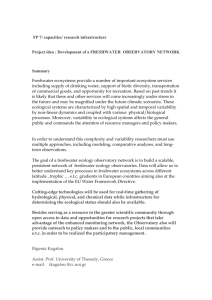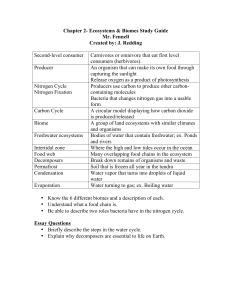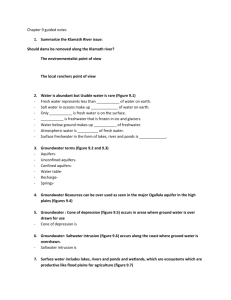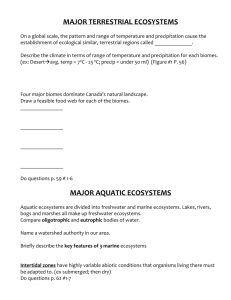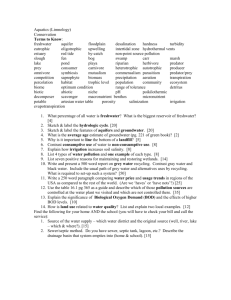protecting freshwater ecosystems within the
advertisement
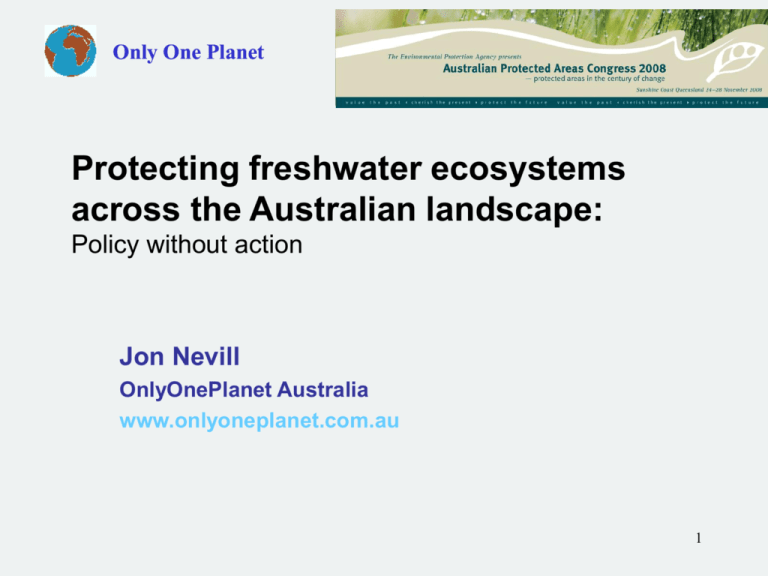
Only One Planet Protecting freshwater ecosystems across the Australian landscape: Policy without action Jon Nevill OnlyOnePlanet Australia www.onlyoneplanet.com.au 1 www.onlyoneplanet.com.au The discussion: • • • • • • The last few decades – State water management Promises: representative freshwater reserves Promises: conjunctive groundwater management Promises: environmental flows, fish passage Promises: farm dams / floodplain diversions Promises: ecosystem protection through land use planning 2 www.onlyoneplanet.com.au Back a decade or two, many statues, policies and procedures put in place by State agencies displayed a reckless disregard for fundamental hydrological or ecological processes : Groundwaters and surface waters were typically managed by different State agencies using different legislation, policies, and licensing procedures, even when the links between surface aquifers and baseflow in creeks and rivers was patently obvious; 3 www.onlyoneplanet.com.au Floodplain harvesting of overland flow was generally uncontrolled, together with the construction of levee banks and channels on floodplains; 4 www.onlyoneplanet.com.au Wetlands were drained or levelled without strategic oversight, sometimes with the active encouragement of State and Commonwealth agencies; 5 www.onlyoneplanet.com.au Scant control was exercised over the construction of farm dams, even in permanent waterways – and without provision for environmental flows or fish passage; 6 www.onlyoneplanet.com.au Crown control over riparian land has been relinquished, sometimes by hand-back of riparian reserves, and sometimes by re-definition of statutory terms such as “watercourse”; 7 www.onlyoneplanet.com.au Water allocations far in excess of catchment capacity were bestowed, draining both rivers and aquifers; 8 www.onlyoneplanet.com.au Unmetered or poorly metered extractions were permitted, even for substantial areas of irrigation; 9 www.onlyoneplanet.com.au The cumulative effects of incremental developments were ignored; and 10 www.onlyoneplanet.com.au Cultures condoning unrestricted use of agricultural water developed, blurring the lines between legitimate use and water theft. 11 www.onlyoneplanet.com.au Representative freshwater protected areas Commitments: Ramsar convention 1971, Stockholm conference 1972, World charter for nature 1982, InterGovernmental agreement on the environment 1992, National strategy for the conservation of Australia’s biological diversity 1996… All Australian States and Territories had made commitments by 2003. Action: more or less complete: ACT strategic programs not completed: Vic ‘87, Tas ’02 no strategic programs WA, SA, NSW, NT, Qld No national inventory of freshwater ecosystems; No conservation status assessment, or gap analysis, by governments 12 www.onlyoneplanet.com.au Representative freshwater protected areas Only ~2% of Australian rivers are protected - without dams and with most of their catchments in designated protected areas. Almost all of these are minor or ephemeral rivers, the major exception being the South Alligator River in the NT. Measured by kilometers of river length. 13 www.onlyoneplanet.com.au Conjunctive water management Commitments: All States agreed to manage linked surface and groundwaters in an integrated fashion: CoAG water reform framework 1996. Action: Number of water management plans employing a conjunctive water balance approach to determining water allocations: WA, NT, SA, Qld, NSW, Vic, Tas, ACT… 2007 >> Zero All States except NSW and Victoria said they had such plans under development or under consideration. 14 www.onlyoneplanet.com.au Environmental flows to groundwater dependent ecosystems Commitments: All States agreed to a list of principles for the supply of environmental flows to surface-water and groundwater dependent ecosystems: CoAG water reform framework 1996. Action: Number of water management plans in 2007 providing for environmental allocations to groundwater dependent ecosystems as per principles: Qld 1 fully compliant, 2 partially compliant WA, SA, 2 each partially compliant NT, NSW, Vic, Tas, ACT >> Zero 15 www.onlyoneplanet.com.au Fish passage… Bream Creek, Tasmania… Important breeding site for diadromous & anadromous spp. 1982, 1992 precaution; 1996 env flows; 2000 State dam provisions… 2007 application approved for an instream dam, with transfer rights. 16 www.onlyoneplanet.com.au Farm dams Cumulative impacts… The volume of farm dam storage in the Murray-Darling Basin is increasing by about 4% per year i.e. doubling every 17.5 years and there are few effective controls on this development. Total flow reduction caused by farm dams in the Murray-Darling Basin to 2006 was about 1900 GL/year. 100-year average MDB catchment ‘natural’ inflow ~ 10,000 GL/yr. Average inflow over the last seven years < 6,000 GL/yr. 17 www.onlyoneplanet.com.au Floodplain diversions Little effective strategic oversight over levee bank construction…. Even when bans or restrictions were put in place, illegal levee banks have been constructed and still remain in place. 18 www.onlyoneplanet.com.au Freshwater ecosystem - protection through landuse planning controls Australian legislation commonly requires State governments (environmental impact statues) or municipal planners (local government planning procedures) to “have regard to” the impacts which a proposed development is likely to have on the environment, including freshwater ecosystems. Legislation must be changed to allow the identification of ‘high value’ ecosystems, and require planners to take a precautionary approach in “seeking to protect” identified environmental values when making decisions regarding development proposals. 19 www.onlyoneplanet.com.au My primary emotion when recalling the past 20 years of environmental law is one of profound disappointment. This disappointment is due to the continuing failure of federal agencies and officials to do a better job of implementing and enforcing our environmental laws… [G]overnment is all too often the environment’s worst enemy. Agencies and officials charged with implementing and enforcing our environmental laws frequently fail to do so. They miss statutory deadlines, water down strict legal requirements, or simply refuse to use their enforcement powers, even when faced with blatant violations of the law… [T]he current situation, where laws are implemented, if at all, only half-heartedly… fosters cynicism and serves to undermine faith in our system of law. US attorney Richard Sutherland, 2000. 20 www.onlyoneplanet.com.au Supporting information: • 17-page paper at www.onlyoneplanet.com.au • Includes key recommendations - strategic catchment planning including precautionary extraction caps – surface and groundwaters; - support for strategic planning with freshwater ecosystem inventories, gap analysis, and ‘sites of importance’ and stronger planning legislation. 21 www.onlyoneplanet.com.au The policy process: • • • • • • • • Problem identified: expert reports, working groups, public consultation; official government commitment to action: “no child shall live in poverty“ (Bob Hawke 1993) policy and legislation developed (- business case for necessary investment not developed); implementation through departmental programs, budgets; the easy bits of the proposed program are commenced immediately; harder bits with public liability or strong constituency support are begun after delays; harder bits without public liability or constituency support are never implemented; departmental annual reports discuss successes, and ignore or re-package failures. • media ignores complex issues, fails to understand or report on ‘slow variables’. 22


